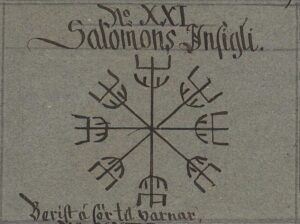These symbols are very popular, and (in part) thanks to the Vikings TV series, many believe they originate from the viking age, or represent something to do with norse beliefs. However, all the evidence suggests otherwise. Here is a summary of what we know about each of them:
Vegvísir
The earliest record we have of the Vegvísir symbol is from 3 Icelandic “grimoires” which all originate from within a few decades of each other in the 19th century. These are the “Huld” manuscript (known as “ÍB 383 4to”), composed in 1860 by Geir Vigfússon (page 60/27r); the “Book of spells” or Galdrakver (known as “Lbs 2917 a 4to”), written in 1869 by Olgeir Geirsson (page 27); and another Galdrakver (“Lbs 4627 8vo”), also from 19th century (page 17v).

The first two sources include the following inscriptions (translated into English): “Carry this sign with you and you will not get lost in storms or bad weather, even though in unfamiliar surrounds.” and “Carry this sign with you and you will not get lost in storms or die of cold bad weather, and will easily find his way from the unknown.” respectively. The third contains this inscription:

“To avoid getting lost: keep this sign under your left arm, its name is Vegvísir and it will serve you if you believe in it – if you believe in God in the name of Jesus – the meaning of this sign is hidden in these words, so you may not perish. May God give me luck and blessing in the name of Jesus.”
This last passage has led many to claim that the symbol is “Christian” in nature. Another possibility is that, to avoid persecution by the Christian church (which was dominant at the time of publication) when writing a book of “magic spells”, the editor included reverations to the Christian God. Other posters will claim that, because the three books also contain many other norse magic and norse mythology references, that this too is a norse symbol. But that also overlooks the fact that the books contain a strange mixture of various different beliefs. There is no way to conclusively attribute the symbol to one religion or another.
It is often incorrectly stated that Vegvísir was pictured in the “Galdrabók”. This error is due to Stephen Flowers, who published a paper entitled “The Galdrabók: An Icelandic Grimoire” in which he did include a picture of Vegvísir, as part of a side-note on grimoires in general.
In the book “Icelandic Magic Symbols and Spell Books”, Davíðsson reports a case in 1664 when a book of magic was confiscated from a student by his teacher. The contents of the book were described, and included “#41: To get no storms at sea, accompanied by a figure”. The name of the symbol was not mentioned and the symbol itself was not shown. This could indicate a potential prior reference to Vegvísir, but this is only speculation.
Ægishjálmur
I use the Icelandic name “Ægishjálmur” to distinguish the symbol from the physical helmet with the old-norse name “Œgishjalmr”, both of which are known as the “Helm of Awe”. The “Helm of Awe” is mentioned in several Eddic poems and in the Völsunga Saga. But in all these sources, it is clear that the “Helm of Awe” is referring to an actual, physical helmet (not a symbol). The helmet itself had the ability to strike fear and terror into the hearts of enemies.
It is possible that the Ægishjálmur was created to reproduce these same effects in magical symbol form (hence the use of the same name). The eight arms of the symbol could be bind-runes of Algiz (perhaps for victory and protection) and Isa (perhaps for “hardening” – literally “ice”). There are no mediaeval sources that reference a symbol which could be interpreted as Ægishjálmur.

The oldest known attestation of the Ægishjálmur symbol is in the 1670 “Galdrakver” manuscript known as “Lbs 143 8vo”.
In the magic spell book described by Davíðsson, it also mentioned Ægishjálmur by name (symbol number 20), which implies that the name was well-known enough by that time (1664).
Depictions of Ægishjálmur vary over the centuries, but one interesting note is from an early 19th century manuscript known as “JS 375 8vo”, in which a “squared” version of Ægishjálmur, identified as “The Greater Ægishjálmur” (there are other Ægishjálmur versions elsewhere in the manuscript) and is described as “This is the seal of Moses”.
Finally, let’s go back to the “Huld” manuscript and consider page 25v, where a symbol, again remarkably similar to Ægishjálmur, is labelled “Seal of Solomon”.

Origins

Both symbols have an 8-pointed “star” pattern to them. This is not common for norse-era symbols other than their “sun wheels”, which all have different numbers of arms where depicted. No graffiti, artefacts, tapestries or jewellery depicting anything else remotely similar to either symbol have been found from the “viking age”.
In my own personal opinion, the most plausible origin is from England, where this style of symbol can be found from the 15th century in manuscripts such as the “Solomon testament” (“Harley MS 5596”). But similar symbols have also been found on 16th century drawings of Danish drinking horns, so this is far from conclusive evidence.
References
https://sagy.vikingove.cz/en/origins-of-the-vegvisir-symbol/
https://handrit.is/manuscript/view/is/IB04-0383/55?iabr=on#page/26v/mode/2up
https://handrit.is/manuscript/view/is/Lbs04-2917a/31?iabr=on#page/14v/mode/2up
https://handrit.is/manuscript/view/is/Lbs08-4627/35?iabr=on#page/17v/mode/2up
Flowers, Stephen: The Galdrabók: An Icelandic Grimoire (1989)
Davíðsson, O: Icelandic Magic Symbols and Spell Books (1903). Translated J. Foster, 2015.
https://sonsofvikings.com/blogs/news/in-defense-of-the-vegvisir-symbol
https://handrit.is/manuscript/view/is/Lbs08-0143/25?iabr=on#page/10v/mode/2up
https://www.brutenorse.com/blog/2018/5/14/the-gishjalmur
https://handrit.is/manuscript/view/is/JS08-0375/91?iabr=on#page/46v/mode/2up
https://handrit.is/manuscript/view/is/IB04-0383/53?iabr=on#page/25v/mode/2up

